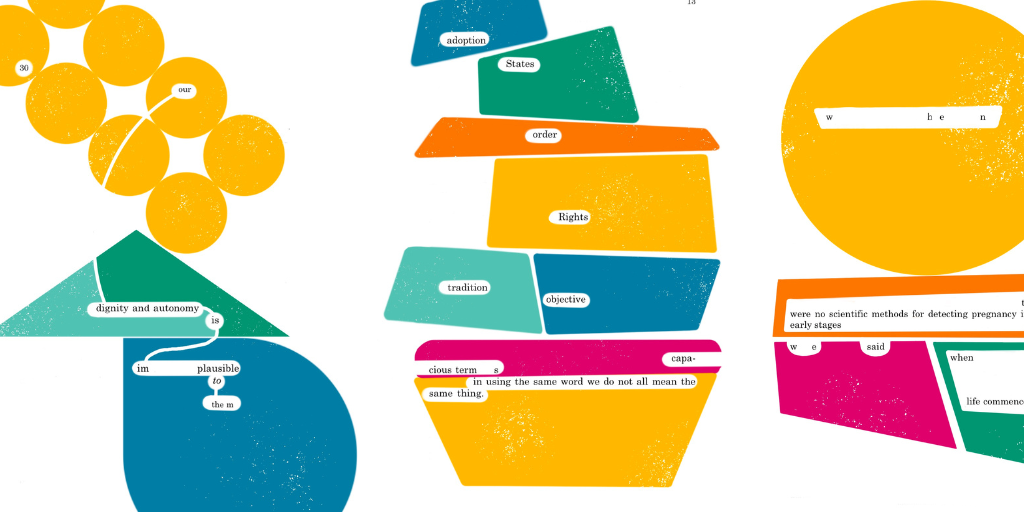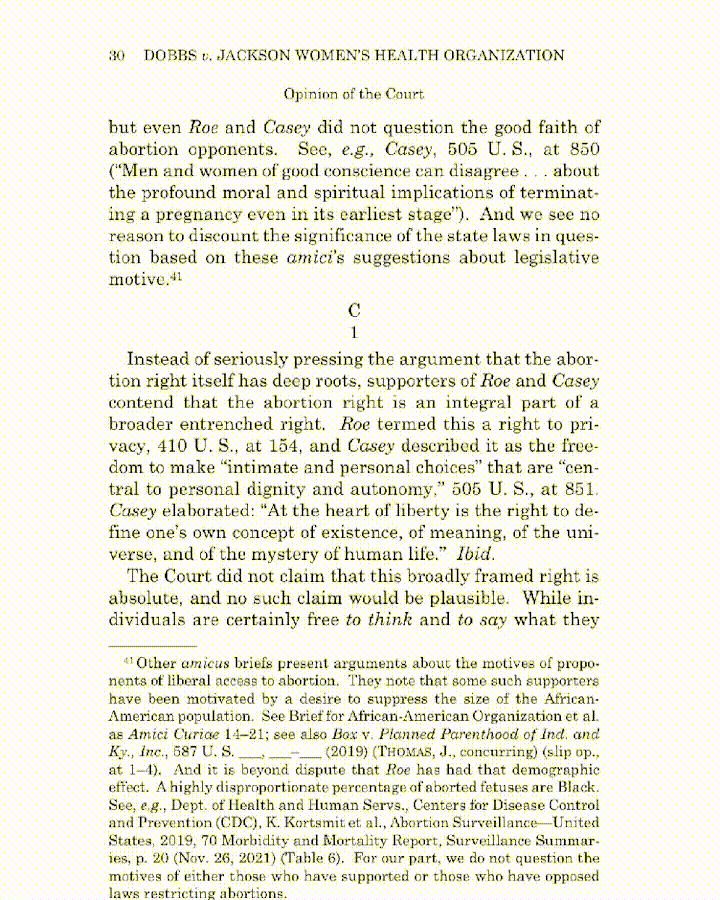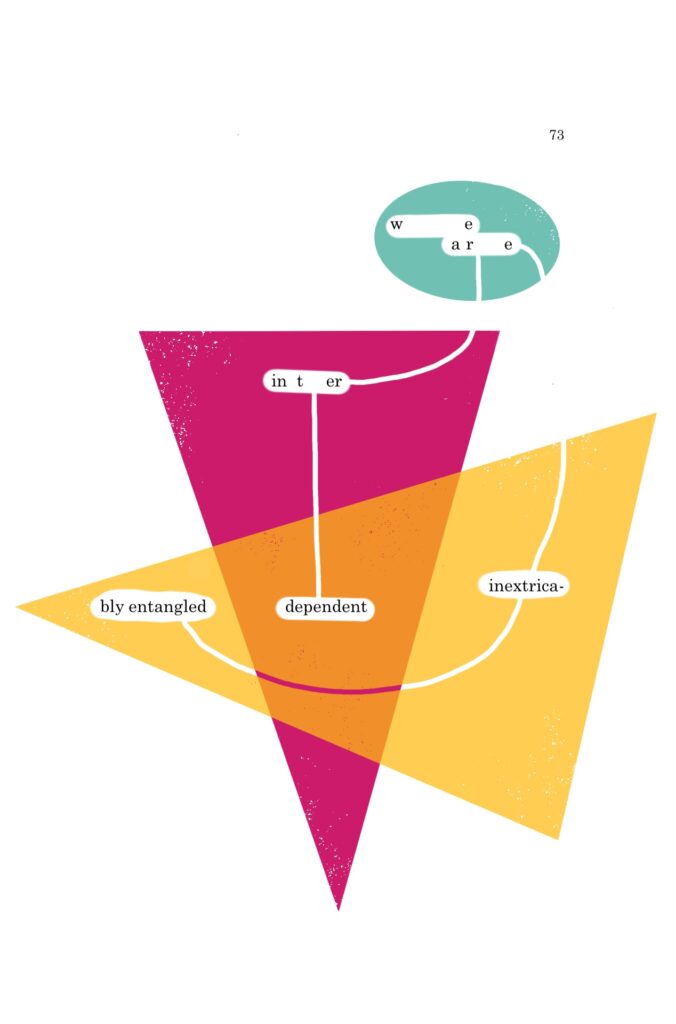
It has been one year since the Dobbs v. Jackson Women’s Health Organization ruling ended federally protected abortion rights and threatened many more. Doctoring Dobbs is a response to this ruling that melds my work as cultural anthropologist, advocate for reproductive justice, and artist.
Doctoring Dobbs is a gallery of erasure poems I created by strategically “doctoring” each page of the Dobbsruling, removing select words to reveal new messages about the histories, harms, and hopes entailed in the Court’s seismic changes to US reproductive law. Developing this gallery has been a cathartic mix of creative play and critique, as well as an act of hope. I offer itas a contribution to ongoing conversations about reproductive rights and justice, and as an invitation to experiment with the ethics of erasing to reveal.
What is Erasure?
In simple terms, erasure is a creative process that removes material from an existing source to reveal something new. The word comes from the Latin root –radare, which means to scrape off or remove. Artists have been practicing erasure methods on found objects for decades, perhaps centuries. Countless sources have been erased, from charcoal drawings to dictionary entries to the Declaration of Independence, each generating new meaning with what remains. Erasure goes by other names, like found poetry, deletion, redaction, refraction, and obliteration. It enjoys diverse audiences, from museumgoers to Instagram-scrollers, and beyond.
How I Came to Erasure.
I first encountered erasure years ago during a talk delivered by Robin Coste Lewis, who discussed the genre’s racial politics and antiracist potential. Soon after the Dobbs ruling, erasure came to mind while listening to a podcast on a long drive. Writer Austin Kleon was speaking to an interviewer about his book, Newspaper Blackout, a compilation of erasure poems he made from excerpts of the New York Times and a black marker. “I didn’t know what I was doing, or why,” he writes in the book’s preface. “All I knew was that it was fun to watch those words disappear behind that fat black marker line. It didn’t feel like work, it felt like play.”
How I Came to Erasure.
Compelled by its simple premise and the promise of play, I began erasing. I first marked up beloved magazines, then playful prompts from my partner, later instructions for self-managing abortion. I experimented with markers on paper, though I enjoyed a digital pen on a tablet most. I erased with various goals: to amplify, to subvert, to connect, to honor, to deviate, to destroy. I imagined erasing other things, like medication inserts, product advertisements, Reddit forums, road signs, historic speeches, diary entries, and political testimony.

Deep play induced deep reflection on the ethics and politics of erasure: Who gets to erase? When should I work with or against a source, or not at all? How does the violent use of erasure within oppressive systems (e.g., colonialism, imperialism, capitalism, racism, patriarchy) relate to its creative counterpart? What needs removing and what needs revealing? This deep reflection seeded ideas for Doctoring Dobbs.
Starting with a few ingredients—a free PDF of the 79-page majority ruling, a tablet (iPad and Apple pencil), and image editing software (ProCreate)—I began to alter each page of Dobbs, in sequential order. At first a private endeavor with no goal beyond creative immersion, I shared early examples on social media and eventually applied for funding to curate an online gallery.
What is Dobbs?
Dobbs is the 2022 ruling by the US Supreme Court that overturned federal protections for abortion rights. In the year since the decision, there has been immeasurable legal chaos and social harm, the full degree to which remains unknown. We know that accessing abortion after Dobbs has required people to navigate rapidly changing state policies, spend more money, travel farther, and experience graver risks to their health and well-being. Many are bearing forced pregnancies in a country that has egregiously high infant and maternal mortality rates, especially for Black and Brown people, no universal parental leave or childcare, and inaccessible supports for mental health. As was true for abortion-seekers before Dobbs, people who are young, trans, gender expansive, undocumented, low-income, precariously housed, and/or of color are bearing the brunt of these harms. I set out to “doctor” Dobbs because I felt that the harms and hopes entailed in the decision needed revealing.



What is “Doctoring”?
Doctoring means both the altering of a text as well as how a skilled healer remedies an ailment. The poems collected here “doctor” Dobbs in both senses of the word by revealing the violent incursions of state power in our bodies and lives and the role of reproductive justice advocacy in realizing a more just world.
Specifically, I approach “doctoring” as a practice of amending and mending. The poems amend Dobbs to create new meaning by visually changing the existing text. Amending has special meaning in the context of law, where altering a legal document results in amendments, and thus it feels like a good way to describe the process of erasing a Supreme Court opinion. Relatedly, the poems mend by drawing attention to the importance of healing in social justice movements, especially within reproductive justice. Conceived originally by women of color activists, reproductive justice focuses on creating the social, economic, and other structural conditions that ensure the collective thriving of all. To thrive, advocates teach that we must acknowledge and abolish harmful systems—colonialism, racism, capitalism, patriarchy, queer and trans-phobia, etcetera—as well as tend the wounds these systems cause. I take up their call by using the art and ethics of erasure to call out violent legacies that undermine everyone’s ability to thrive, and to emphasize messages of collective power, care, and healing.
Acts of Hope.
Dobbs has been a beginning as much as an ending. As we continue to learn about the reach of the ruling’s social harms, I am heartened by the ongoing work of advocates, policymakers, and providers who are conceiving futures in which we might all thrive. It is noteworthy that abortion rights are surging in popularity. It matters that legal strategists, healthcare providers, and activists are actively collaborating on bold ideas for more just reproductive and sexual health care. It is important to follow reproductive justice advocates who continue to lead the way by visioning the world we want and deserve.
In the wake of Dobbs, I hold fast to artist and activist Corita Kent’s view that “doing and making are acts of hope.” I found that erasure—the art of undoing and re-making—can be an act of hope too. Without knowing what I was looking for, Doctoring Dobbs revealed to me that we—by which I mean anyone living within harmful, unjust systems—are our own remedy. I hope this project amplifies lessons from reproductive advocates about the importance of rest, celebration, imagination, and showing up in all ways and always, as they remain necessary ingredients for realizing a more just world.
Risa Cromer, PhD is an Assistant Professor of Anthropology at Purdue University and affiliate faculty of American Studies, Women’s, Gender, and Sexuality Studies, and Critical Disability Studies programs. She is author of the forthcoming book Conceiving Christian America: Embryo Adoption and Reproduction Politics (NYU Press). You can follow her on Twitter @rcromer and @doctoringdobbs.